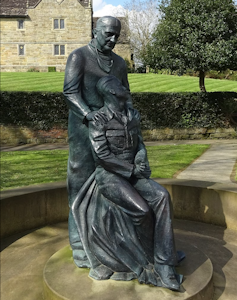
How do you begin the process of researching a novel? In the case of my latest book, Man at Sea, the task seemed straightforward if a little daunting.
The novel is partly set during the second world war, so I spent a lot of time combing the Imperial War Museum archives. It also examines Malta’s transition from British colony to independence in the 1960s, so I was fortunate enough to undertake several research trips to the island.
As a writer, the key is not so much assembling reams and reams of material, but finding the details that make a period or situation vivid for you and, eventually, for the reader – those few facts which make a sprawling and multi-faceted topic specific enough to relate to and empathise with. The novelist Sarah Waters once memorably described those nuggets of information as the “poignant trivia” that provides the canvas for historical fiction.
As a creative writing lecturer, I teach students to not judge their historical fiction purely on historical accuracy, but on its ability to evoke an emotional response. This is what academic Melissa Addey describes in her research as a “playful exploration set within the frame of the historical record”, which allows for incorporation of smaller, more idiosyncratic details.
Other research points to the useful distinction between accuracy and authenticity, with the latter allowing for the character-based detail that a reader will connect with.
For me, the initial wartime narrative clicked with the discovery of the Guinea Pig Club. This was the moniker adopted by a group of airmen badly burned in action who were operated on by the pioneering plastic surgeon, Archibald McIndoe, in East Grinstead in Sussex.
At that point, I knew that one of the protagonists of the novel, Stuart, had been injured in the war, but the Guinea Pig Club provided a wealth of detail and characteristics that really brought him to life. In July 2017, I made my first visit to the “town that didn’t stare”, where the club’s honorary secretary, Bob Marchant, showed me around the Queen Victoria Hospital.
Here were the cedarwood huts which I’d seen in the background of photographs showing men with bandaged faces and long trunk-like skin grafts as they waited for their next surgery. And the balconies over the operating theatre from which fellow patients used to watch procedures undertaken by McIndoe. Back at the East Grinstead Museum, Bob showed me the archive of club magazines.
In those pages I found the camaraderie which my character would pine for in those long post-war years, the sense of support and belonging which could sustain him in navigating civilian life.
And I was genuinely moved to find the Christmas 1960 issue with a memorial to McIndoe who had died that year. At the end was the simple statement: “There are no words.” The Guinea Pig Club, and the debt of gratitude the members owed to their surgeon, became the core of Stuart’s character.
But the emotional link to Malta itself, though, came from much closer to home.
A family story
Back in 1956, my grandparents lived in Malta while my grandfather was stationed with the Mediterranean fleet. My late grandmother, Marian Scrimgeour, kept a diary which was ideal for providing distinctive detail.
She didn’t experience the fierce air raids of the siege of Malta, but she did navigate the Suez Crisis with two young children in tow. So, her account of daily life includes notes such as: “Watched review of Nato ships whilst hanging out washing on roof. Cook. Dinner. A and J to sleep”. That steadfast continuation of the everyday domestic tasks while tensions escalated provided valuable insight for imagining life on the island during the war.
I also found an entry in which she is passing notes with a friend via the “ice man”, and there is a mention, in late April, of the milk going sour overnight. In the novel, I used those small allusions as a way of the characters noting the arrival of the hot Maltese summer.
These real experiences had the benefit of feeling period-specific and would have been nigh-on impossible to gain from my own trips, some 60 years later. I was also fortunate in being able to speak with my grandfather, Murray Scrimgeour, about his memories before he passed away.
I have scrawled notes about his ship, the HMS Duchess, and the position of the admiralty in Malta. But the most valuable elements I gleaned from him were the specific naval references, such as Lord Mountbatten, second in command of the Mediterranean fleet, being disparagingly referred to as the “straw-boss”; and the “two-tier” wardroom, or officer’s mess, with the Maltese taken on mostly as stewards for the British officers.
My grandfather told me what it was like to be moved to a “war footing” and having to evacuate his young family from the island by way of a flight on a decommissioned WWII bomber with a faulty fourth engine.
He also related just how dangerous driving his hired Morris Minor had felt, and it is as a nod to him that the character of Stuart observes that the locals all “drove like ricocheting bullets”.
The historical and the personal
Reading back over the finished novel now, it is lines like these which make me smile. It is easy to search out a newspaper article or an official report for the facts, but finding that kind of detail which sharply evokes the experience of living in that historical moment is so much more important for the novelist.

As Man at Sea is released into the world, then, my hope is that the “poignant trivia” Waters speaks of provides a sense of connection and immediacy. My bookshelves are filled with authoritative accounts of the second world war and detailed analyses of Malta’s journey to independence, but the passages in the narrative which readers will hopefully relate to are those provided by the Guinea Pig Club and especially by my late grandparents.
I’ve learned that the key to writing historical fiction is not providing all of the facts and figures, but combing through your research and pinpointing the one detail in ten which the reader can emotionally connect with. It is the human experience that truly resonates.
Liam Murray Bell receives funding from the Society of Authors.
This article was originally published on The Conversation. Read the original article.







